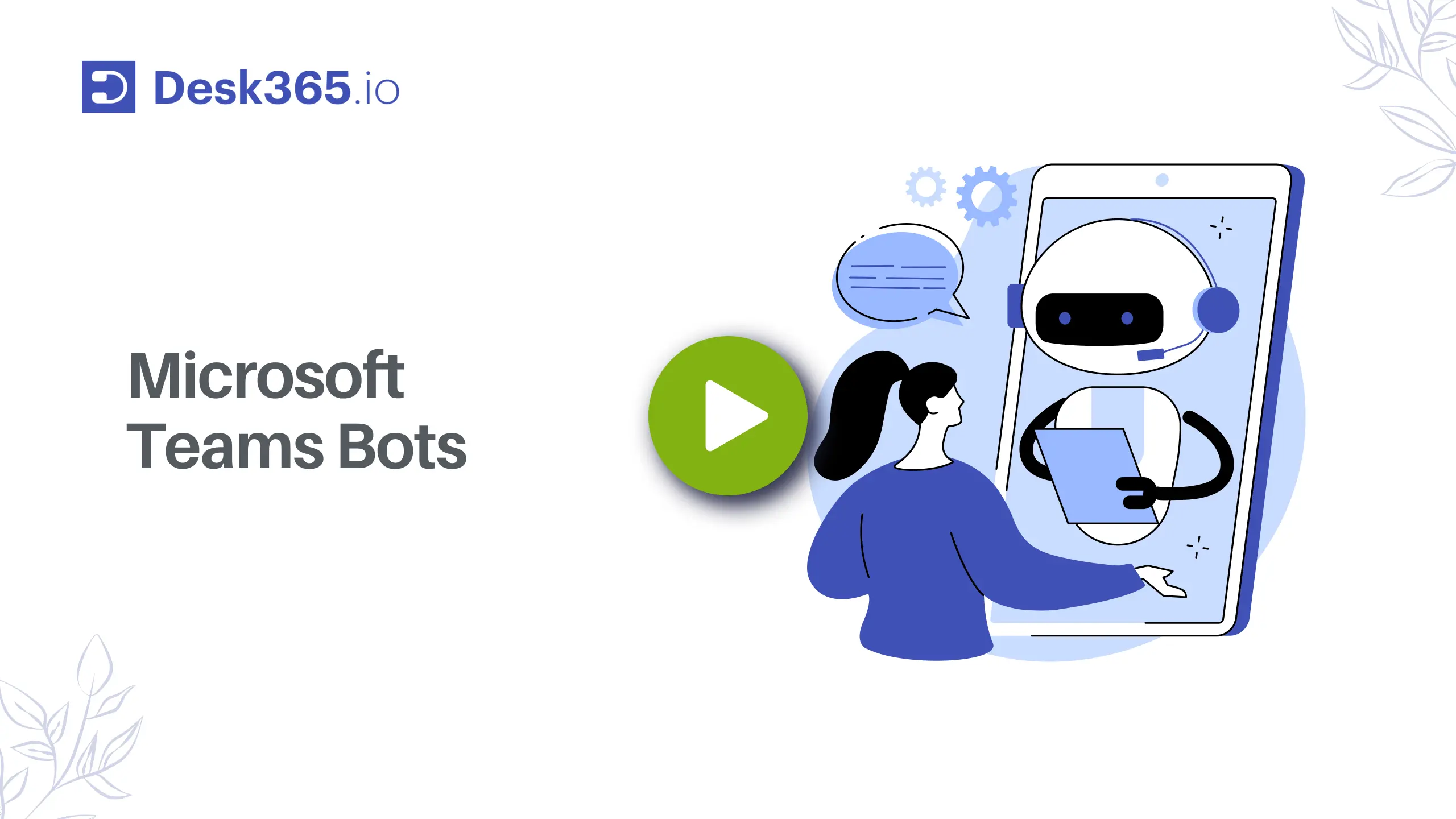In customer service, managing the ticket queue is essential for smooth operations. When there’s a flood of support tickets, your team can quickly feel overwhelmed, leading to slower response times, frustrated customers, and potential loss of business. However, the right approach to ticket queue management can transform your helpdesk into an efficient and organized system.
In this blog, we’ll explain what ticket queues are, why managing them matters, best practices to manage them, and how Desk365 can simplify this process for your team.
What is ticket queue management and why is it important?
Ticket queue management is the process of organizing, categorizing, and prioritizing support tickets to ensure a smooth workflow. It helps your team deliver timely and effective customer support while balancing workloads evenly. It involves categorizing tickets based on urgency, type, or customer segment and assigning them to the right support agents. This ensures that no query gets overlooked, and every customer receives timely assistance.
Proper ticket management can:
- Improve response times.
- Boost customer satisfaction and loyalty.
- Prevent agent burnout.
- Ensure critical issues are resolved promptly.
Research underscores its importance: Studies show that, 59% of customers abandon a brand after a single poor experience, and 13% of dissatisfied customers share their bad experiences with 15 or more people. These statistics underscore the importance of addressing customer issues promptly and professionally. A well-managed ticket queue management system ensures that customer issues are resolved promptly, leading to happier customers and better business outcomes.
How ticket queue management works?
Effective ticket queue management organizes, prioritizes customer support tickets, ensures timely responses, improves agent productivity, and elevates customer satisfaction. It involves leveraging tools, workflows, and strategies that optimize how tickets are handled, assigned, and resolved. Here’s a detailed breakdown:
1. Helpdesk ticketing system
A helpdesk ticketing system acts as the backbone of ticket queue management by centralizing all customer inquiries into one unified platform.
- Centralized inbox: All customer requests from various channels—email, phone, web forms, chat, Microsoft Teams, or support portals—are stored in one place, reducing the risk of missing or duplicating tickets.
- Tracking and logging: Each ticket is logged with relevant details such as the issue type, customer history, and time of submission. This ensures transparency and easy tracking throughout the resolution process.
- Improved collaboration: With a centralized system, agents can collaborate effectively by sharing notes, updates, and insights directly within the ticket interface.
Read more – 9 Free Ticketing Systems You can Trust in 2026
2. Ticket process workflow
The ticket workflow is a systematic process that ensures tickets are handled efficiently from submission to resolution. Key steps include:
- Ticket creation: Customers submit tickets through various omnichannel options like email, web widgets, or support portals. Self-service options, such as FAQs or support guides, help reduce the number of incoming tickets by allowing customers to resolve common issues independently.
- Categorization and prioritization: Tickets are categorized based on topics (e.g., technical, billing) and urgency (e.g., high, medium, low priority). This ensures that critical issues are resolved first, preventing delays.
- Ticket assignment: Using predefined rules, tickets are automatically routed to the most suitable agent or team, minimizing manual intervention and ensuring faster response times.
- SLA compliance: Service level agreements (SLAs) set clear deadlines for ticket resolution times. Automation escalates unresolved high-priority issues to higher authorities, ensuring accountability.
- Resolution and collaboration: Agents work to resolve tickets, collaborating with teammates or other departments if needed. Shared visibility ensures smooth teamwork.
- Reopening tickets: If a customer feels an issue is unresolved, they can reopen the ticket for further investigation, ensuring a high standard of service.
Recommended Reading: How does Ticket Routing help in Customer Service?
Strategies for effective ticket queue management
Effective support ticket queue management relies on a combination of well-defined strategies. Each of these strategies contributes to reducing ticket backlogs, improving response times, and enhancing customer satisfaction.
1. Omnichannel support
Omnichannel support ensures that customers can engage with a business through their preferred communication channels, such as email, phone, live chat, or support portals, all while maintaining a unified interaction history. By consolidating all these interactions into a single system, agents gain access to the complete history of conversations in one unified inbox. This eliminates the need for customers to repeat their issues across channels, reducing frustration and enhancing satisfaction.
Furthermore, this centralized approach allows agents to respond more quickly and accurately, as they have all the necessary context readily available. The seamless communication provided by omnichannel support improves overall customer experience by making assistance more accessible and interactions more fluid.
2. Automate workflows
Automation plays a critical role in streamlining ticket management processes, reducing the workload on agents, and enhancing operational efficiency. One key aspect of automation is the ability to sort tickets automatically based on predefined criteria, such as the type of issue, urgency, or customer tier. This ensures that tickets are immediately categorized and prioritized for resolution.
Additionally, automated routing and escalation direct tickets to the most appropriate agents or escalate unresolved issues in accordance with SLA rules, ensuring that no critical issue is overlooked. By automating repetitive tasks, such as sending ticket acknowledgment emails or updating statuses, teams can save significant time and minimize errors. This allows agents to focus on resolving customer concerns rather than managing administrative tasks.
Recommended Reading: Customer Service Automation: The Complete Guide
3. Use canned responses and self-service options
Providing immediate solutions to frequently encountered issues is essential for reducing ticket volumes and enhancing efficiency. Canned responses, which are pre-written templates for common queries, enable agents to reply instantly and consistently, thereby improving response times and maintaining service quality.
Self-service options, such as FAQs, knowledge bases, and how-to videos, empower customers to resolve minor issues independently. This reduces the overall workload on support teams and ensures that agents are available to handle more complex or high-priority tickets. By integrating these tools into the customer support strategy, businesses can significantly improve the speed and quality of service.
Recommended Reading: 12 Best Canned Response Templates for Customer Support Emails
4. Prioritize tickets wisely
Effective ticket prioritization is crucial for addressing urgent customer issues promptly while maintaining operational efficiency. One method of prioritization is the first-come, first-served approach, which is suitable for smaller teams with manageable ticket volumes. However, this method may not be ideal for scenarios where critical issues require immediate attention.
Larger teams often benefit from a complexity-based prioritization strategy, where tickets are sorted and resolved based on urgency or SLA guidelines. This ensures that high-priority issues are tackled first, regardless of when they were submitted, minimizing potential customer dissatisfaction caused by delays in addressing critical concerns.
5. Optimize workforce management
Workforce management is a key element in ensuring that the right resources are allocated to resolve tickets efficiently. By matching tickets to agents with the relevant expertise—such as assigning technical queries to technical specialists or billing inquiries to financial experts—businesses can improve resolution quality and speed.
Additionally, analyzing ticket volumes and agent availability allows for effective workload balancing, ensuring that no team member is overwhelmed or underutilized. Dynamic resourcing, which involves adjusting staffing levels in real time, is particularly useful during sudden spikes in ticket volumes, helping businesses maintain consistent service levels even during peak periods.
6. Encourage continuous learning
A culture of continuous learning equips agents with the skills and knowledge they need to handle tickets more effectively. Encouraging knowledge sharing within the team allows agents to learn from each other by discussing how challenging tickets were resolved, fostering collaboration and collective growth.
Providing opportunities for skill development, such as workshops, webinars, and training sessions, helps agents stay updated on best practices and build their confidence. Continuous learning not only enhances individual performance but also improves the overall efficiency and expertise of the support team, resulting in better customer service.
7. Define automation rules
Automation rules are essential for ensuring that tickets are routed and handled efficiently from the moment they are created. By implementing dynamic routing, businesses can automatically direct tickets to the most appropriate department or agent based on predefined criteria, such as the type of issue or customer priority.
Customized escalation rules further enhance efficiency by automatically raising unresolved tickets to higher levels of authority based on urgency or SLA breaches. This tailored approach to automation not only speeds up ticket resolution but also ensures that critical issues are addressed without delay, ultimately improving customer satisfaction and operational effectiveness.
Recommended Reading: Helpdesk Automation: The Ultimate Guide & Top 7 Tools
10 tips to enhance ticket queue management
- Dedicate a team to sort tickets and flag critical ones.
- Respond to simple queries quickly to reduce the queue size.
- Address recurring issues by improving self-service resources.
- Regularly update your knowledge base for better customer support.
- Gather customer insights for personalized responses.
- Automatically assign tickets to agents based on expertise.
- Escalate complex queries to senior agents for efficient resolution.
- Use internal notes for seamless collaboration.
- Prioritize tickets based on customer time zones to ensure timely support.
- Rotate roles and assign additional tasks, like reviewing canned responses or updating FAQs, to keep agents motivated and skilled.
Benefits of effective ticket queue management
Effective ticket queue management improves customer service by streamlining operations and empowering support teams to work efficiently. Here are the key advantages:
Benefits of ticket queue management
- Simplified ticket handling: Organizes tickets based on urgency or type, making it easier to focus on high-priority issues.
- Faster response times: Automation and prioritization ensure urgent tickets are resolved quickly, reducing customer frustration.
- Consolidated customer interactions: Centralizes communication, giving agents a complete view of the customer’s history for better support.
- Personalized support: Access to past interactions enables agents to offer tailored solutions and address recurring issues.
- Improved team collaboration: Facilitates teamwork by allowing agents to share notes and escalate tickets seamlessly.
- Reduced manual workload: Automation handles routine tasks, freeing agents to focus on more complex issues.
- Insightful performance tracking: Provides metrics to assess and improve team performance through data-driven insights.
1. Simplified ticket handling
When support tickets come in large numbers, managing them can feel overwhelming. Effective ticket queue management helps by organizing tickets based on urgency, type, or customer category. This organization ensures your team can focus on high-priority issues instead of being distracted by a messy inbox.
2. Faster response times
A good ticket management system speeds up responses by automating workflows, sending real-time notifications, and prioritizing urgent tickets. This efficiency helps your team respond quickly, reducing customer frustration and improving overall service.
Recommended Reading: How to Improve Customer Service Response Times?
3. Consolidated customer interactions
Nobody likes repeating themselves, and agents perform better when they have access to complete customer histories. A ticket system keeps all conversations—whether through email, phone, or chat—organized in a single thread. This makes it easier for agents to understand and address customer needs without confusion.
4. Personalized support
Personalization is crucial for excellent customer service. A ticket system lets agents access past interactions, giving them the context they need to offer tailored support. Instead of treating each query as a new problem, agents can build on the customer’s history, addressing recurring issues or preferences effectively.
Recommended Reading: 8 Easy Ways to Deliver Personalized Customer Service
5. Improved team collaboration
A ticketing system makes it easier for team members to work together. Multiple agents can contribute to the same ticket by sharing notes, tagging colleagues, and exchanging insights, all while keeping the process organized. It also streamlines escalations by quickly directing tickets to the right departments or specialists.
6. Reduced manual workload
Automation is a game-changer for reducing repetitive tasks. By handling routine processes like ticket sorting and status updates, the system frees up agents to focus on more complex issues. This not only prevents burnout but also helps the team manage their workload more effectively.
7. Insightful performance tracking
Without clear data, improving customer service is challenging. A ticketing system offers tools to measure key performance metrics, providing a real-time overview of how your team is doing. This insight helps identify trends, resolve bottlenecks, and make informed decisions to enhance support operations.
Recommended Reading: 12 Helpdesk Metrics to Improve Customer Support
Experience seamless ticket queue management
The challenges of poor ticket queue management
Without effective management, ticket queues can create chaos, leading to:
Challenges of poor ticket queue management
- Agent burnout: Overwhelmed agents feel stressed by a constant influx of tickets.
- Missed priorities: Critical issues may go unresolved, increasing churn.
- Inconsistent service quality: Poor queue organization can damage your brand reputation.
- Buried tickets: Important queries might get lost in the clutter.
- Uneven workload: Some agents may be overworked while others remain underutilized.
1. Agent burnout
When ticket queues are not properly managed, agents face a constant influx of tickets with no clear system to prioritize or assign tasks. This leads to feelings of being overwhelmed, as they struggle to keep up with a seemingly endless stream of issues.
Burnout can have severe consequences, including decreased agent productivity, reduced quality of work, and higher employee turnover. Stressed agents are also less likely to engage positively with customers, potentially resulting in bad customer service experiences.
2. Missed priorities
Without a clear prioritization system, urgent issues may not receive the attention they need. For example, a critical technical issue might remain unresolved because agents are focused on less important tasks that were submitted earlier.
This failure to address high-priority tickets can frustrate customers, damage their trust in your company, and ultimately increase the churn rate. Customers expect timely resolutions to their problems, especially when the issues are urgent.
3. Inconsistent service quality
A poorly organized ticket queue leads to an uneven customer experience. Some tickets may be resolved quickly, while others are delayed without reason. This inconsistency can frustrate customers, causing them to lose confidence in your ability to provide reliable support.
Over time, inconsistent service quality can ruin your brand’s reputation. Negative experiences are often shared widely, potentially affecting your ability to attract and retain customers.
4. Buried tickets
In a cluttered and disorganized ticket queue, important customer queries can easily get buried under less critical issues. This means some tickets may go unnoticed for an extended period, leaving customers waiting for a response—or worse, giving up altogether.
Unanswered or delayed tickets reflect poorly on your support team’s efficiency and professionalism. They can also lead to negative reviews and a drop in customer satisfaction.
5. Uneven workload
When ticket queues are not properly routed among support agents, some team members may end up handling an excessive number of tickets, while others remain underutilized.
This imbalance can cause overworked agents to feel stressed and exhausted, leading to errors and reduced productivity. Meanwhile, underutilized agents may feel disengaged, resulting in missed opportunities to improve overall team efficiency.
Ticket queue management with Desk365
Desk365 transforms ticket queue management by providing a suite of powerful features designed to optimize customer support processes. By streamlining ticket organization, automating routine tasks, and fostering collaboration among support teams, Desk365 helps improve efficiency and ensures that customers receive timely, high-quality service.
Here’s how Desk365 simplifies ticket queue management with powerful features:
- Unified inbox: Consolidates customer queries from email, chat, support portal, etc. into a single dashboard.
- Advanced ticket sorting: Sort tickets using predefined ticket fields, such as priority level, issue type, or customer category.
- Ticket prioritization: Prioritize tickets based on urgency or SLA requirements.
- Automation: Automates ticket assignment, and escalation to save time and improve efficiency.
- Omnichannel support: Provides a seamless experience by connecting multiple communication channels.
- Collaboration tools: Enables agents to share notes and work together on complex tickets.
- Insightful analytics: Offers real-time metrics to monitor performance and identify areas of improvement.
Desk365 makes ticket queue management both efficient and effective. These features not only help streamline support operations but also empower agents to deliver faster, more personalized service. With powerful automation and insightful analytics, Desk365 ensures that your team can maintain optimal performance while providing a superior experience for customers.
Frequently asked questions
It is the process of organizing and prioritizing customer support tickets for efficient resolution.
Effective queue management is achieved by categorizing, prioritizing, and automating ticket routing based on urgency and predefined criteria.
The ticket queue consolidates customer queries into a unified inbox, with automation handling ticket sorting, assignment, and escalation for efficient resolution.
Desk365 automates workflows, supports omnichannel communication, and provides analytics for continuous improvement.
Yes, Desk365 allows you to set and monitor SLA rules to ensure timely responses.







